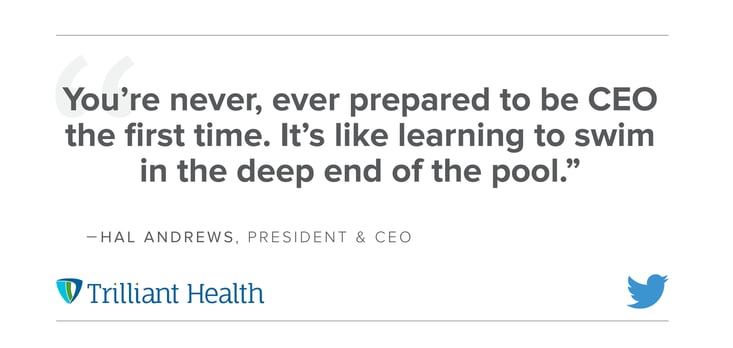Counterpoint
Hal Andrews | November 17, 2021Building While Flying: Lessons from a 5x Healthcare Startup CEO
This conversation originally aired on Building While Flying, a podcast from the Sasha Group.
[4 MIN READ | 32 MIN LISTEN]
Trilliant Health’s President and CEO, Hal Andrews, spoke with Mickey Cloud on the Building While Flying podcast about his career path as a lawyer turned entrepreneurial healthcare executive. He touches on the importance of hospitals as community anchors, some challenges he faced on being a CEO, and more.
You can listen to the full conversation (32 minutes) directly below or scroll down for a brief overview.
Note: The Q&As below are paraphrased from the conversation.
Q: How does Trilliant Health work with hospital systems and healthcare providers?
Hal: We work with health systems in a couple of ways. One – we refer to it as market analytics – where we give our customers an idea of what's happening outside the four walls of their facilities. Everybody knows what's happening inside their hospital. But historically, hospitals didn't understand what was happening outside those four walls. As healthcare is delivered in more outpatient ambulatory primary care physician-based settings, they have less visibility; therefore, they have less understanding of real market share trends.
The second thing we do is work with health systems on predictive analytics. As Peter Drucker once said that a hospital is the most complicated organism in the world because it has high labor costs, high capital cost, and a high regulatory burden. Our customers are making capital allocation decisions for buildings that should have a 10 or 20 or 50 or even 100-year useful life. Trying to predict what's going to happen in the market 10-50 years from now is important to make sure that you allocate your capital prudently.

Q: What opportunities and challenges did COVID pose for Trilliant as a company over the past 18 months?
Hal: The biggest challenge for us is that our customers are primarily health systems. Those health systems were under extraordinary and unprecedented pressure. They had to deal with the fact that they were simultaneously the most important provider in the community, and yet they were putting in place protocols to mitigate against the pandemic. They had to be there for folks as they were fighting an unknown virus while everyone figured out what was going on.
The problem for the communities they serve is that based upon regulation the federal government asked people to stop doing outpatient surgeries. The result of that is delays in care. Delays in care always lead to one of two things: either that care is foregone permanently or the condition is worse by the time somebody comes back. Our clients are managing through both of those things simultaneously this year.
Q: What is a priority should when you're thinking about turning a business around?
Hal: The first thing that I do and have been doing for a decade, is implement what's called the daily update. I learned this from one of my mentors and his version was, progress updates, takeaways from the day, and gratitude. I've taken those three things and added an excerpt from The Daily Drucker because I find that Dr. Drucker seems to have the most wisdom of any business writer out there. Every day, I do all four of those things and share it with every employee. Providing full transparency in what I have done that day and where the company stands through my lens.
Q: Do you have a mission statement, values, or purpose and how does it help guide your organization?
Hal: Yes, we have what we call a noble purpose. And our noble purpose is to help hospitals and health systems with growing their market share through intelligent patient acquisition. The reason for that is hospitals are the economic center of the communities they serve. Not only are they there to be the provider of last resort, but healthcare systems provide jobs and the impact on the local economy means they are essential to the communities they serve. A strong hospital exists in a strong community, and a weak community almost always has a weak hospital. So, the health of the hospital has a huge ripple effect, not only in terms of the care that's delivered in the community, but in the community itself.
Learn more about Trilliant Health’s 2021 report by downloading it here.
- Podcast






















.png)

















.png?width=171&height=239&name=2025%20Trends%20Report%20Nav%20(1).png)

